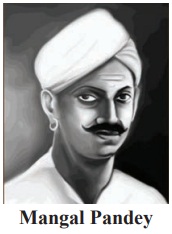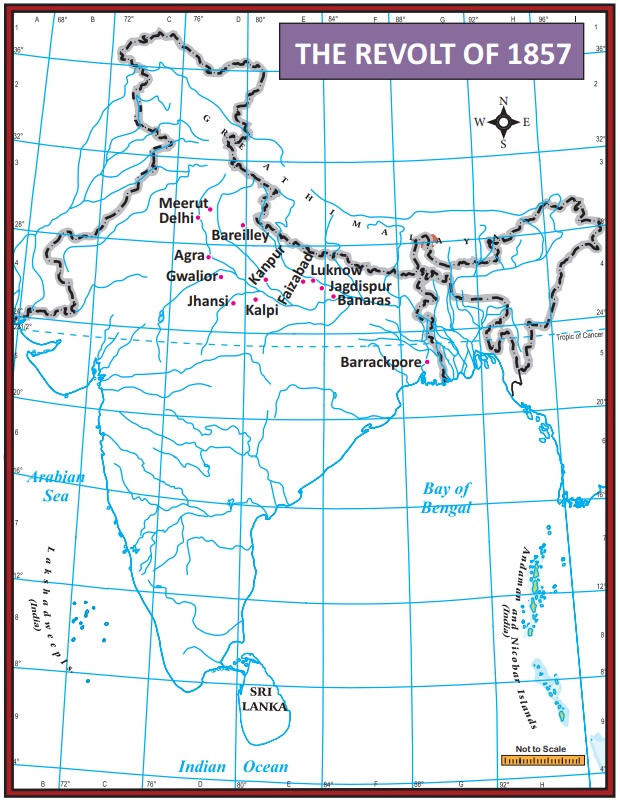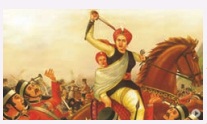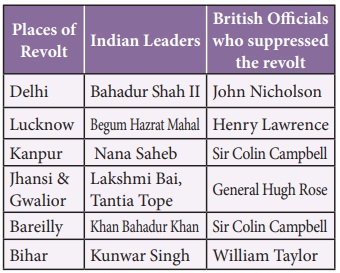People’s Revolt | Chapter 4 | History | 8th Social Science - The Revolt of 1857 | 8th Social Science : History : Chapter 4 : People’s Revolt
Chapter: 8th Social Science : History : Chapter 4 : People’s Revolt
The Revolt of 1857
The Revolt of 1857
The early uprisings did not succeed
in threatening the British in India. It took the Revolt of 1857 to bring home
to the Company and the British thought that their rule was not accepted to a
large section of the population. The Revolt of 1857 was a product of the
character and the policies of colonial rule. The cumulative effect of British
expansionist policies, economic exploitation and administrative innovations
over the years had adversely affected the positions of all rulers of Indian
states.
Causes of the Revolt
* The most important cause of revolt
1857 was a popular discontent of the British policy of economically exploiting
India. This hurt all sections of society. The peasants suffered due to high
revenue demands and the strict revenue collection policy.
* Policies of doctrine of lapse,
subsidiary alliance and policy of Effective Control created discontentment
among people. Annexation of Awadh (Oudh) proved that even the grovelling
loyalty can't satisfy British greed for territories.
* The conversion activities of
Christian missionaries were looked upon with suspicion and fear. The priests
and the maulavis showed their discontent against the British rule.
* Abolition of practices like sati,
female infanticide, support to widow remarriage and female education were seen
by many as interference in their Indian culture by the Europeans.
* The Indian sepoys were looked upon
as inferior beings and treated with contempt by their British officers. They
were paid much less than the British soldiers. All avenues of the promotion were
closed to them as all the higher army posts were reserved for the British.
Immediate cause
The immediate cause was the
introduction of new Enfield Riffles in the army. The top of the cartridge of
this rifle was to be removed by the mouth before loading it in the rifle. The
cartridges were greased by the fat of pig and the cow. The Indian sepoys
believed that the British were deliberately attempting to spoil the religion of
both the Hindus and the Muslims because while the Hindus revered the cow, the
Muslims hated the pig. The soldiers, therefore, determined to refuse their
service and, ultimately revolted. Thus, the primary and the immediate cause of
the revolt was the use of the greased cartridges.
The Outbreak of the Revolt
On 29 March 1857 at Barrackpur (near
Kolkata) Mangal Pandey, a young Sepoy from Bengal Regiment, refused to use the
greased cartridge, and shot down his sergeant. He was arrested, tried and
executed. When this news spread many sepoys revolted.

Course of the Revolt
On 10 May 1857, the Sepoys of the
third cavalry at Meerut openly revolted by swarming the prisons and releasing
their comrades. They were immediately joined by the men of the 11th
and 20th Native Infantries, and they murdered some English officers
and then marched to Delhi. The arrival of Meerut sepoys at Delhi on 11th May
and declared of Bahadur Shah II as the Emperor of India.

Delhi became the centre of the Great
Revolt and Bahadur Shah, its symbol.
The revolt spread quickly. There
were mutinies at Lucknow, Kanpur, Jhansi, Bareilly, Bihar, Faizabad, and many
other places in north India. Many of them found that it was a good opportunity
to burn the papers of their landlords. Many others whose titles and pensions
were abolished by the British who participated in it, inorder to take revenge.

In Central India the
revolt was guided by Rani Lakshmi Bai of Jhansi. She was one of the greatest
patriots of India. Sir Hugh Rose occupied Jhansi. Rani Lakshmi Bai fled from
Jhansi and joined hands with Tantia Tope who had assumed the leadership of the
rebel army at Gwalior. But the British captured Gwalior in June 1858. Rani was
killed in the battle. Tantia Tope fled away but was captured and later
executed. According to the British historians, present at the time of revolt,
Rani Lakshmi Bai was the best and the bravest among the leaders of the Revolt
of 1857.
Suppression of the Revolt
Lord Canning, the governor- general
took immediate steps to suppress the revolt. He collected the forces of Madras,
Bombay, Sri Lanka and Burma. On his own initiative, he called the British army
which was deputed to China by Britain to Calcutta. He ordered the loyal Sikh
army to proceed to Delhi immediately. The British regained their lost positions
very soon.
Delhi was recaptured by General John
Nicholson on 20 September, 1857 and deportation of Bahadur Shah II to Rangoon
where he died in 1862. Military operations with the recovery of Kanpur were
closely associated with the recovery of Lucknow. Sir Colin Campbell occupied
Kanpur. Nana Saheb was defeated at Kanpur and escaped to Nepal. His close
associate Tantia Tope escaped to central India, was captured and put to death
while asleep. The Rani of Jhansi had died in the battle-field. Kunwar Singh,
Khan Bahadur Khan were all dead, while the Begum of Awadh was compelled to hide
in Nepal. The revolt was finally suppressed. By the end of 1859, British
authority over India was fully re-established.

The Causes for the Failure of the
Revolt
Various causes were responsible for
the failure of the revolt.
* Lack of organisation, discipline,
common plan of action, centralised leadership, modern weapons and techniques.
* The rebel leaders were no match to
the British Generals. Rani Lakshmi Bai, Tantia Tope and Nana Saheb were courageous
but they were not good generals.
* Non-participation of Bengal,
Bombay, Madras, western Punjab and Rajputana.
* The modern educated Indians did
not support the Revolts as they believed that only British rule could reform
Indian society and modernize it.
* The British managed to get the
loyalty of the Sikhs, Afghans and the Gurkha regiments. The Gurkhas actually
helped the British in suppressing the revolt.
* The British had better weapons,
better generals, and good organisation.
Consequences of the Revolt
* The Revolt of 1857 marked a
turning point in the history of India. It led to changes in the system of
administration and the policy of the Government.
* The administration of India was
transferred from the East India Company to the British Crown through the
‘Queen’s Proclamation’ in 1858.
* The governor general was given the
title of viceroy.
* The Board of Directors and the
Board of Control were replaced by the Council of 15 members headed by the
Secretary of State to supervise Indian affairs.
* The Indian Army was thoroughly
reorganised. More Britishers were employed in the army.
* The British military policy came
to be dominated by the idea of ‘divide and counterpoise’.
Infact, the Revolt of 1857 played an important role in bringing the Indian people together and imparting them the consciousness of belonging to one country. The Revolt paved the way for the rise of the modern national movement. It was at the beginning of the twentieth century that the 1857 Revolt came to be interpreted as a “planned war of national independence”, by the Historian V.D. Savarkar in his book, 'First War of Indian Independence'.
Related Topics